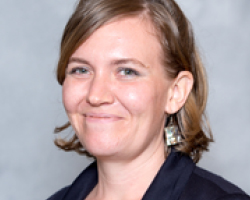Can Physics Educators Create a More Encouraging Environment for Black, Latino, and Native American Science Students?

How do students from diverse backgrounds experience science?
- Vashti Sawtelle, Ph.D.
- Assistant Professor, Physics Education
- Lyman Briggs College
- Department Physics and Astronomy
- College of Natural Science
Vashti Sawtelle is a physics education researcher who is deeply interested in ethnic, racial, and gender equity. Her work during the past ten years has focused on how students from diverse backgrounds experience science.
It is a topic that Sawtelle considers timely, as well as imperative. There are not enough minorities or women in the field of physics, and the statistics are dispiriting.
The American Institute of Physics (AIP) tracks the data via its Statistical Research Center, which is the source for information about education and employment in physics, astronomy, and other physical sciences. According to a November 2017 AIP report,[1] there were 6,760 bachelor's degrees in physics awarded in the United States in 2013. Of those degrees, 118 were earned by African American, Hispanic, and Native American women.
"We don't even talk about percentages because the numbers are so low," said Sawtelle.
There are repercussions with the lack of diversity. It means that when minority and female students enter a high school or university physics classroom, they are most likely to encounter white, male professors, classmates, and physics professionals.
That poses a few questions. Can we level the playing field to attract, nurture, and encourage people of color? Why don't more women become scientists? What more can be done to encourage them? How should it be done?
Sawtelle studies how mentors, family dynamics, and teachers influence students as they formulate a relationship with science. In some cases, those factors contribute to the withdrawal of a science interest. Integrating ethnographic methodologies into her work provides Sawtelle with key insights into cultural experiences that impact a person's journey toward becoming a physicist.
For Sawtelle, the work is an intersection of professional and personal curiosity.
"I'm a first generation college graduate, and I grew up in a predominantly low-income region of central Ohio. Even though I was intrigued by science—and physics in particular—I didn't feel like I had adequate exposure in school to support my interests. Early on, I asked myself ‘Who gets to do science?' I didn't feel well prepared, or necessarily supported. That certainly influenced me," said Sawtelle.
That was Sawtelle's first experience with science education. She was captivated early on by the patterns and rules of the universe. She earned a bachelor's in physics from Grinnell College in Iowa while struggling with a demanding academic environment that left her feeling like she hadn't had enough preparation along the way. "I wondered how some of the other students became so comfortable with physics and scientific concepts. It made me wonder what I had missed," said Sawtelle. After graduation she spent two years as a researcher at the Battelle Memorial Institute in Columbus, Ohio.
Another round of experiences began when she arrived at Florida International University (FIU) in Miami to pursue graduate work in physics. As a Caucasian, Sawtelle was in the minority, not only in the physics classes, but on the campus. FIU's 2017 enrollment reflected a 67 percent majority of Hispanic/Latino undergraduate students; nearly 13 percent were Black or African American, and 9 percent were White.
"It was different for me to be in the minority," said Sawtelle. "My race was part of the conversations when I was at FIU, and it gave me some insight. It also brought up questions about how to address those issues."

Vashti Sawtelle's research focuses on how students universally might become confident science students.
Sawtelle's dissertation, A Gender Study Investigating Physics Self-Efficacy, drew from her own journey into the field. She accepted a postdoctoral research associate position at the University of Maryland Physics Education Research Group. During that time she developed curriculum for life science majors and researched student understanding across chemistry, physics, and biology.
Over time, Sawtelle has broadened her research from experiences of women in physics to the question of how students universally might become confident science students—and how those identities are related to issues of racial and gender equity in the science community.
How Do You Start a Racial Equities Conversation in a University Physics Class?
In 2016, Sawtelle collaborated with Abigail R. Daane, then an assistant professor of physics at Seattle Pacific University (SPU) and now a physics professor at South Seattle College, to facilitate discussion and activities related to "what it means to do physics, who does it, and why particular groups of people are not proportionally represented in the field."[2]
Working with SPU students in an introductory physics course, Daane and Sawtelle gleaned information about the students' experiences, perspectives, and opinions about physics and the diversity within the field.
Based on that work, Sawtelle, Daane, and undergraduate SPU student Sierra R. Dicker developed Teaching About Racial Equity in Introductory Physics Courses,[3] a unit that instructors can incorporate into introductory physics courses at the university level, preparing and guiding the class through delicate and difficult conversations about physics, race, gender, and individual responsibilities. Students were asked to reflect on whether physics is subjective or objective, whether diversity is important, and what individual students can or will do to address these inequities in the field of physics.
Sawtelle and Daane included the Supreme Court case and the Justices' comments in their classroom activities. They asked students what their reactions were to the first question, along with "How would you answer Justice Roberts' question?"
Sawtelle and Daane presented their paper at the Physics Education Research Conference in Sacramento, California in July 2016.
Discussing race, equity, biases, and the reasons to address these topics during physics class time can lead to uneasiness and frustration. Student responses ranged from:
- Diversity is generally good in all contexts (64.2%)
- Physics is objective and fact-based (19.4%)
- Physics is not objective (3.0%)
- Equity should not be a topic in physics class (7.4%)
- Diversity benefits minority students (6.0%)
"These Can Be Difficult Conversations to Have"
Sawtelle developed a workshop focused on race, ethnicity, and equity in the context of physics education that was included in the program at the American Association of Physics Teachers (AAPT) 2017 National Conference. Others involved in the workshop are MSU colleagues Angela Little and Abhilash Nair, Chandra Turpen of the University of Maryland, Katemari Rosa from the Federal University of Campina Grande in Brazil, and Jesus Pando of DePaul University. She acknowledges that a discussion about racial and gender equity in the field is difficult in a physics class.
The workshop was designed for anyone who was interested in examining education spaces through the lenses of race and ethnicity, but Sawtelle and the organizers especially encouraged AAPT attendees who might have felt novice about discussions surrounding identity, culture, privilege, microaggressions, implicit bias, and colorblind rhetoric.
"Sure, it's a tough topic. If there is one Black student in a physics class of 200 people do you treat that student differently? Is the Black student using intellectual energy worrying about being Black? Do the White students notice the lack of diversity?" said Sawtelle. "We are trying to give physics teachers the tools to address racial disparities and diversity, and understand the current impact it has on physicists, as well as future physicists. Based on the responses from our workshop, we seem to have hit on a topic that people want to learn about."
Sawtelle received positive feedback on the AAPT workshop evaluations. "Our workshop is designed to raise student awareness, and empower those students to be agents of change. It's clear from the feedback we have received that physics educators are open to the work that we have done. It's an important—and timely—topic."
Sources
- 1 Merner, L., & Tyler, J. (2017, November). African American, Hispanic, and Native American women among bachelors in physical sciences and engineering: Results from 2003–2013 data of the National Center for Education Statistics. College Park, MD: American Institute of Physics, Statistical Research Center. Retrieved from https://www.aip.org/statistics/reports/african-american-hispanic-and-native-american-women-among-bachelors-physicalExternal link - opens in new windowBack to Article
- Daane, A. R., & Sawtelle, V. (2016, December 29). Student discourse about equity in an introductory college physics course. In D. L. Jones, L. Ding, & A. Traxler (Eds.), Proceedings of the Physics Education Research Conference (pp.88-91). doi:10.1119/1perc.2016.pr017. Retrieved from https://www.compadre.org/per/items/detail.cfm?ID=14200External link - opens in new windowBack to Article
- Daane, A. R., Decker, S. R., & Sawtelle, V. (2017). Teaching about racial equity in introductory physics courses. The Physics Teacher 55, 328. Retrieved from https://doi.org/10.1119/1.4999724External link - opens in new windowBack to Article
- Corneliussen, S. T. (2015, December 18). "What unique perspective does a minority student bring to a physics class?" Physics Today. Retrieved from http://physicstoday.scitation.org/do/10.1063/PT.5.8155/full/External link - opens in new windowBack to Article
- Written by Carla Hills, University Outreach and Engagement
- Photograph courtesy of MSU Communications and Brand Strategy